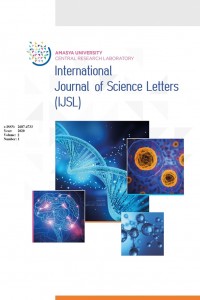Abstract
References
- Liu, X., Atwater, M., Wang, J., & Huo, Q. (2007). Extinction coefficient of gold nanoparticles with different sizes and different capping ligands. Colloids and Surfaces B: Biointerfaces, 58(1), 3-7.
- Optical characterization of ZnO nanoparticles capped with various surfactants. Journal of Luminescence, 129(5), 434-438.
- Gary, D., & O’Reilly, E. (1986). Instrumental Analysis: Boston, London, Sydney, Toronto: Allyn and Bacon Inc.
- Kalantar-zadeh, K., and Benjamin Fry. (2008). Nano Fabrication and Patterning Techniques. In K. Kalantar-zadeh & B. Fry (Eds.), Nanotechnology-Enabled Sensors (pp. 135-210). Boston, MA: Springer US.
- Kocabiyik, S., Aslan, B., & Müller, R. (1995). Cloning and expression of a haloacid dehalogenase from Pseudomonas sp. strain 19 S. Biodegradation, 6(3), 217-222.
- Pavia, D. L., Lampman, G. M., Kriz, G. S., & Vyvyan, J. A. (2008). Introduction to spectroscopy: Cengage Learning.
- Thomas, O., & Causse, J. (2017). Chapter 2 - From Spectra to Qualitative and Quantitative Results. In O. Thomas & C. Burgess (Eds.), UV-Visible Spectrophotometry of Water and Wastewater (Second Edition) (pp. 37-72): Elsevier.
The effects of concentration based on the absorbance form the ultraviolet–visible (UV-VIS) spectroscopy analysis
Abstract
This experiment utilizes the material characterization technique known as UV-Vis spectroscopy. The aim of this research is to study the UV-Vis absorption spectroscopy readout in order to investigate the effect of concentration on absorbance for gold solution and to determine the value of band gap for powder sample (TiO2). The types of TiO2 specimens can be characterized on a solid form of powder, thin film and/or in a liquid form. The preparation of each state of specimen are varies. In this current research, Liquid samples of Au nanoparticles dispersed in different concentrations of ethanol were characterized using UV-Vis technique. The absorbance versus concentration plot of the Au-ethanol samples were found to obey Beer’s law. When examining the solid state in a form of TiO2 powder, the sample need to be packed before running the experiment. To calculate the band gap of each matter from the reflectance data of UV-Vis, the graph of energy (eV) versus is plotted. The J-curve is identified quickly, extrapolating the tangent to intersect the x-axis to obtain the band gap value.
Keywords
References
- Liu, X., Atwater, M., Wang, J., & Huo, Q. (2007). Extinction coefficient of gold nanoparticles with different sizes and different capping ligands. Colloids and Surfaces B: Biointerfaces, 58(1), 3-7.
- Optical characterization of ZnO nanoparticles capped with various surfactants. Journal of Luminescence, 129(5), 434-438.
- Gary, D., & O’Reilly, E. (1986). Instrumental Analysis: Boston, London, Sydney, Toronto: Allyn and Bacon Inc.
- Kalantar-zadeh, K., and Benjamin Fry. (2008). Nano Fabrication and Patterning Techniques. In K. Kalantar-zadeh & B. Fry (Eds.), Nanotechnology-Enabled Sensors (pp. 135-210). Boston, MA: Springer US.
- Kocabiyik, S., Aslan, B., & Müller, R. (1995). Cloning and expression of a haloacid dehalogenase from Pseudomonas sp. strain 19 S. Biodegradation, 6(3), 217-222.
- Pavia, D. L., Lampman, G. M., Kriz, G. S., & Vyvyan, J. A. (2008). Introduction to spectroscopy: Cengage Learning.
- Thomas, O., & Causse, J. (2017). Chapter 2 - From Spectra to Qualitative and Quantitative Results. In O. Thomas & C. Burgess (Eds.), UV-Visible Spectrophotometry of Water and Wastewater (Second Edition) (pp. 37-72): Elsevier.
Details
| Primary Language | English |
|---|---|
| Journal Section | Research Articles |
| Authors | |
| Publication Date | March 1, 2020 |
| Published in Issue | Year 2020 Volume: 2 Issue: 1 |


